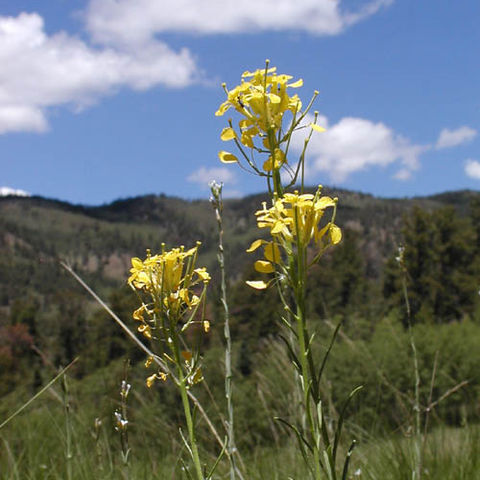Biennials. Trichomes of leaves 2-or 3-rayed. Stems erect, unbranched or branched distally, (0.6-)1.2-6.5(-8) dm. Basal leaves (often withered by fruiting); blade oblanceolate, 2-10 cm × (0.2-)0.5-1.5(-2.4) mm, base attenuate, margins dentate, apex acute. Cauline leaves (distal) sessile; blade margins entire or denticulate. Racemes considerably elongated in fruit. Fruiting pedicels horizontal to divaricate, slender, narrower than fruit, 5-16(-25) mm. Flowers: sepals oblong to linear-oblong, 8-12 mm, lateral pair slightly saccate basally; petals yellow, obovate to suborbicular, 13-22 × 4-9 mm, claw 8-15 mm, apex rounded; median filaments 8-14 mm; anthers linear, 2.5-4 mm. Fruits widely spreading or divaricate, narrowly linear, usually straight, rarely curved upward, not torulose, (3-)5-12(-14) cm × 1.2-2.7 mm, 4-angled, strongly (longitudinally) 4-striped; valves with prominent midvein and replum, densely pubescent outside, trichomes 2-rayed between midvein and replum, glabrous inside; ovules 72-120 per ovary; style cylindrical, slender, 1-4 mm, sparsely pubescent; stigma slightly 2-lobed, lobes as long as wide. Seeds ovoid, (1-)1.3-2.3 × 0.7-1.2 mm; usually not winged, rarely winged distally. 2n = 36.
More
Erect biennial or short-lived perennial, 2–10 dm; lvs linear to oblanceolate, entire or with a few low teeth; sep 1 cm; pet bright yellow to orange-yellow, 1.5–2.5 cm, the blade half as long as the claw; mature racemes much-elongate, with stout, divergent pedicels 7–15 mm; frs ± spreading, 4–10 cm; 2n=36. Prairies, sand-hills, and open woods; O. to Minn. and Mo., and widespread in w. U.S., rarely adventive farther e. along railroads. May, June. (Cheirinia a.; Erysimum arkansanum) Our plants, representing the Great Plains phase of the sp., are var. asperum.

